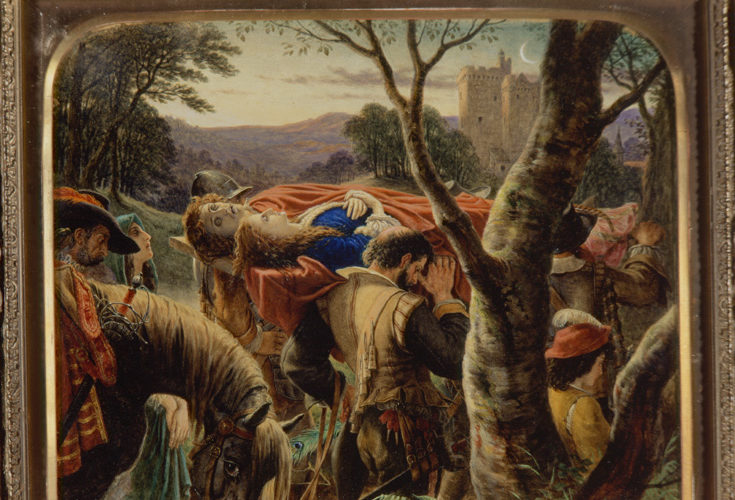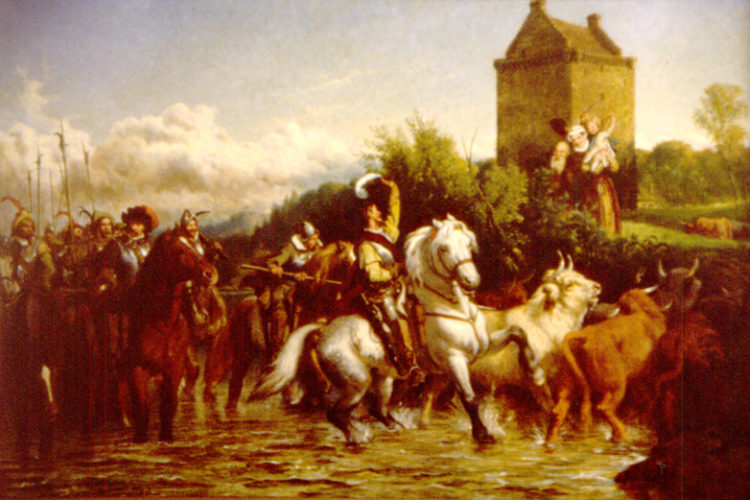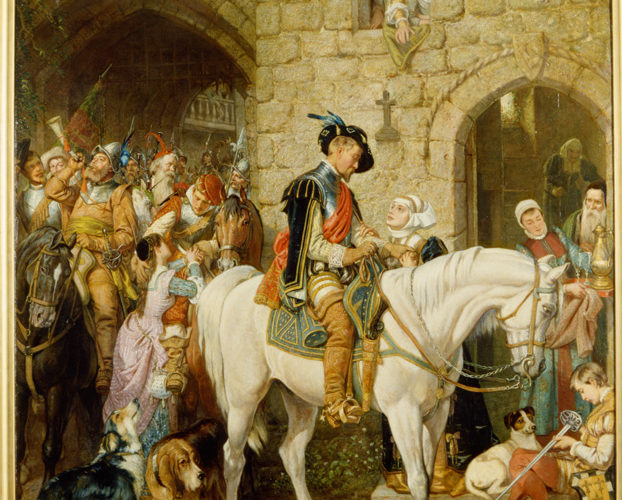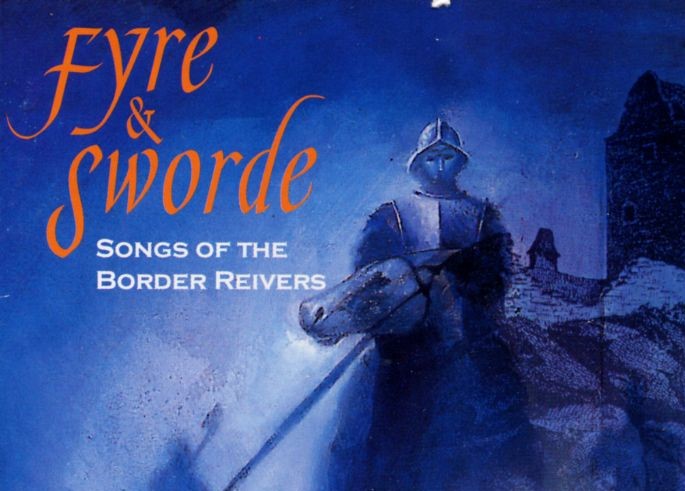Painting of Johnnie Armstrong's Return, by Henry Hetherington Emerson. Henry Hetherington Emerson (1831-1895) was a…

Dowie Dens of Yarrow, painting by Sir Joseph Noel Paton with ballad
Painting of The Dowie Dens of Yarrow, by Sir Joseph Noel Paton 1821-1901.
Joseph Noel Patton (1821-1901) was best known for his paintings of historical, mythical and religious subjects. He was born in Dunfermline and was a friend of Millais and was in sympathy with, though not a member of the Pre-Raphaelite Brotherhood. He published a book of his own poetry in his later years.
One of the best-known of Border Ballads “The Dowie Dens of Yarrow” survives in numerous variations. The best known text is the version that Sir Walter Scott compiled for his “Border Minstrelsy”. In Paton’s mournful painting the last act of the tragedy is enacted as the ill-starred lovers are carried to the grave.
Late Victorian historicism and romanticism are combined in Sir Joseph Noel Paton’s painting which seems a curious confusion of Romeo and Juliet with the Flower of Yarrow and her servan’ lad from Gala. In Scott’s ballad the lady “refused nine noble men, For a servan lad from Gala”. He is killed in an unfair fight with her brothers and his body is thrown in the Yarrow. Her mourning is dismissed by her father with the promise “I’ll wed ye to a better lad, Than ye have lost in Yarrow”.
The Dowie Dens of Yarrow seems to have some factual basis, at least some of the characters have been convincingly identified. The ballad begins “At Dryhope lived a lady fair, The fairest flower of Yarrow”. The heroine of the tale may be the daughter of the notorious Reiver, Scott of Dryhope. Later in the poem the heroine is called the “Rose of Yarrow” and Border tradition identifies her as Mary Scott, the daughter of John Scott of Dryhope, who married Walter Scott of Harden in 1576.
“Auld Wat of Harden” as he was later known, was a formidable Reiver, said to have ridden by a haystack on his return from a foray and famously remarked “Aye if ye had fower legs ye wouldnae stand there lang”.
The story of this ballad has a familiar ring as a tragedy. It is quite probably based in some way on a true story but historical records of such things are frequently bitty. However there are a few clues, as Child records. Contemporary records for the presbytery of Selkirk record violent feuds between the Scotts of Tushielaw and the Scotts of Thirlestane. In 1616 a Walter Scott of Tushielaw eloped with Grizel Scott of Thirlestane without her fathers permission, and a few years later the trial of Simeon Scott of Bonytoun and three others is recorded as taking place at Melrose for the ‘horrible slaughter’ of one Walter Scott. Since this all happened close to where the ballad is set, it seems likely that there may be a connection.
| The Dowie Dens o’ Yarrow (Text) | |
| There was a layde lived in the North, | As she gaed owre yon hill sae high |
| Her name it was called Sara, | An’ doon yon den sae narrow |
| She was coorted by nine noblemen, | ‘Twas there she spied her true love John |
| And a plooman lad frae Yarrow. | A bloody corpse in Yarrow. |
| As he gaed owre yon hill sae high | She wash’d his face and kemm’d his hair |
| An’ doon yon den sae narrow | As aft she’d dune afore O |
| ‘Twas there he met nine armed men | An’ she washed the reed blude frae his wounds |
| Come to fecht wi’ him in Yarrow. | Wi’ muckle grief and sorrow. |
| Noo ye are a’ come to fecht wi me | Her hair it was three quarters lang |
| In the dowie dens o’ Yarrow | An’ the colour o’ it was yallow |
| But there’s nine o’ you and but ane o’ me | She’s tied it roon his middle sae sma’ |
| An’ its’s nae an equal marrow. | An carried him hame frae Yarrow. |
| There’s nine o’ you an’ but ane o’ me | O daugter dear dry up your tears |
| An’ it’s nae an equal marrow | Dry up your tears o’ sorrow |
| But I will fecht ye, ane by ane | An’ I’ll find to you some prettier man |
| In the dowie dens o’ Yarrow. | Than the lad ye lost in Yarrow. |
| Three he slew, and three withdrew | O ye may tak’ your seven sons |
| And three lay deadly wounded | An’ wed them all tomorrow |
| But in behind cam’ her brother George | But a fairer flower ne’er sprang in June |
| An’ pierced his body thorough. | Than the lad I lost in Yarrow. |
| Noo ye’ll gang hame my cruel freen | O mither dear ye’ll mak’ my bed |
| An’ tell your sister Sara | Ye’ll mak’ it saft an’ narrow |
| That her true love John lies dead and gone | An’ there I’ll lie an’ thus I’ll die |
| In the dowie dens o’ Yarrow. | For the lad I lost in Yarrow. |
| O mither dear I ha’e dreamed a dream | Her mither then did mak’ her bed |
| An’ I wish’t may prove nae sorrow | She made it saft an’ narrow |
| I dreamed I pu’d the heather bell | An’ her tender heart it soon did break |
| On the bonnie braes o’ Yarrow. | An’ she died afore ’twas morrow. |
| O daughter dear I can read your dream | |
| But I fear it will prove sorrow | |
| For your true love John lies dead an’ gone | |
| In the dowie dens o’ Yarrow. | |
Image filename: Painting Dowie Dens DU
Copyright of image: University of Dundee Museum. Not available for licence. Do not copy except for classroom use.



